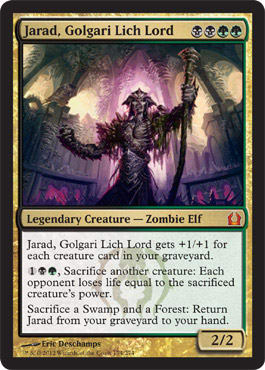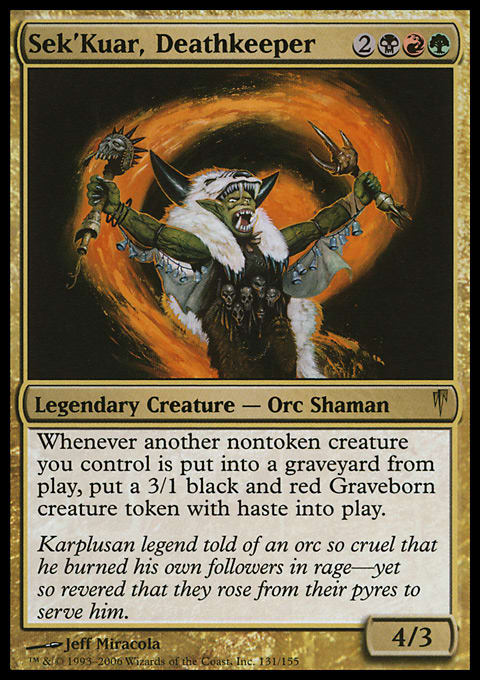Last week, I unveiled my most recent list for my Teysa, Orzhov Scion Commander deck. The deck seeks to leverage Teysa’s ability to generate tokens and exile creatures to control the board. The changes I made were designed to pump off the offensive output of the deck and make the tokens more than just fodder for Teysa’s carefully crafted plans. The responses I received on Twitter were largely positive, but a few people brought up the same question:
“Why aren’t your running Darkest Hour?”
My go-to answer for so long was that I didn’t want it to be easy. I didn’t want to just have an endless supply of tokens that could trigger Goldnight Commander or Maw of the Obzedat at will. This was Commander, and I wanted to be able to earn my victories.
Then Spike came along. Spike is the part of my Magic personality that lingers in the back, driving me to win Drafts and occasionally encouraging me to play sixty-card Constructed and started whispering, “Why?”
Why indeed. Commander is supposed to be a format in which huge plays are commonplace and where things that should not happen are actually happenstance. Putting Darkest Hour into my Teysa deck wasn’t a matter of card availability—I have an Urza’s Saga original in my Commander box—but was inhibited by my own personal restrictor plate. This makes even less sense since the changes I made to Teysa last time were designed to give the deck a chance to do its thing.
Spike wasn’t content to let the matter lie. Instead, the drive to win came back and forced me to try to understand why I build some decks with unneeded barriers and others I leave unbounded.
Restrictions Breed Creativity
To say I admire Mark Rosewater would be an understatement. I attempt to consume every drop of content he provides, but even on a good week, I only glean but a taste of the feast he produces. I’ve even started using some of his rules for game design in my everyday work, which has very little to do with the playing of games. One of MaRo’s go-to axioms is that “restrictions breed creativity.” The concept is simple and complex all at once—by placing limits on oneself, it forces you to search for other potential answer.
My favorite deck, Jarad, Golgari Lich Lord’s, is a perfect example of this saying in action. The drive to run Dark Confidant and Dark Tutelage encouraged me to keep all the mana costs under 5, and at the same time, it drove me to look for ways to keep myself alive and be able to fight without giving up too much ground. And then Jarad started winning, and I think that feeling—that ability to win despite the limits I had placed on myself—lit up the Johnny part of my brain. Johnny hadn’t gotten a ton of love in my playing career since so much of it had been competitive. This chance to relax and flex a different set of muscles . . . well, it was just plain old nice. It was so nice that I stopped myself from building decks that could just win easily.
I conveniently forgot that, no matter how strong my deck was, I was going to be sitting at a table with other mages who may have decks of far greater power levels. If I wanted to win, intentionally hindering decks that weren’t overpowered wasn’t going to accomplish my goal. Instead, I would just be giving a leg up to my adversaries.
And here we come to the crux of the issue. In head-to-head games, it is very easy for me to disassociate myself from emotion. It’s just me against them, and I am the hero of the story. With Commander, I want a social experience and the opportunity to sit around with friends and enjoy the games. I want big swings and great stories—except I never cause the big swings, only deaths of tiny cuts. I never wanted to be the guy who sat down at a table with a ninety-nine-card combo deck and just enjoyed myself while other players were left thinking about what deck to run in their next games.
My tournament Magic is confrontational; my Commander is communicable—and not in that diseased way either.
The more I thought about this, the more I realized that by including a card like Darkest Hour in my deck, I wasn’t necessarily going to win once it hit the table, but it would force my opponents to expend resources to fight me directly, as opposed to the other players. It would be a philosophical shift, for sure, whereas I usually try to look as unassuming as possible. The same end can be accomplished through different lines of play wherein the Darkest Hour only comes when it is time to end things.
And this does not even take into account the other ways I can control the path of the game: by playing the spells. If I decide that, in a particular game, I do not want play the Darkest Hour, I can simply hold it in my hand. Not everyone is going to know my list (despite my propensity for publishing them), and if the game around me dictates that I hold back from casting the spell, so be it.
So Teysa will get an update the next time I have the urge. The Darkest Hour will arrive.
The philosophical search did not end with Teysa. Instead, I looked toward my Lyzolda, the Blood Witch deck and tried to understand why I was okay including such board-dominating combos as Mephidross Vampire and Triskelion there but not have such one-two punches in other places. Why is it okay in a Rakdos deck but not in every other deck that can access these cards?
The best answer I have is that I want variety! I have ten decks, and on top of that, six of them run black. This can lead to some repetitive gameplay unless I set up parameters (here we go again). Lyzolda felt right for such an explosive combination, and right now, Teysa feels right for a simple card that can help create some tales of woe.
The deck that taught me it was okay to love the insane plays was my Sek'kuar, Deathkeeper Zombie Horde. During my trip to Grand Prix New Jersey, I ran into friend and Commander writer Jess Striba, and we compared notes on Zombie tribal. We discussed Overseer of the Damned and how perfect it was, and then Jess mentioned how Noxious Ghoul turns the Demon into a pseudo Last Laugh. Spike perked up, but he was pushed back by Johnny.
That was until last week. I took out Sek’kuar for a few solitaire spins and realized a few things. First, the deck already had a few I-win combinations revolving around Gravecrawler, Phyrexian Altar, and cards like Blood Artist, Rage Thrower, or Purphoros, God of the Forge. Second, Sek’kuar was a slower deck without a ton of tutoring, so I would have to assemble these contraptions “the hard way.” Also, there is something satisfying about putting that final piece into place before everyone sees the writing on the wall.
Here is the updated version of Sek’kuar, complete with a few ways to end the game on the spot. Exiling Gravecrawler seems like a smart play.
Sek?Kuar?s Shambling Horde ? Commander | Alex Ullman
- Commander (0)
- Creatures (48)
- 1 Agent of Erebos
- 1 Anger
- 1 Ashen Ghoul
- 1 Blood Artist
- 1 Butcher of Malakir
- 1 Cackling Fiend
- 1 Carrion Feeder
- 1 Cemetery Reaper
- 1 Corpse Connoisseur
- 1 Corpse Harvester
- 1 Crater Hellion
- 1 Creakwood Ghoul
- 1 Death Baron
- 1 Deathbringer Thoctar
- 1 Falkenrath Noble
- 1 Fleshbag Marauder
- 1 Golgari Guildmage
- 1 Graveborn Muse
- 1 Gravecrawler
- 1 Gravedigger
- 1 Grim Haruspex
- 1 Krovikan Horror
- 1 Lord of the Undead
- 1 Massacre Wurm
- 1 Noxious Ghoul
- 1 Overseer of the Damned
- 1 Pharika's Mender
- 1 Phyrexian Delver
- 1 Rage Thrower
- 1 Reassembling Skeleton
- 1 Reclamation Sage
- 1 Shriekmaw
- 1 Skinrender
- 1 Stronghold Assassin
- 1 Undead Gladiator
- 1 Veilborn Ghoul
- 1 Vengeful Dead
- 1 Vengeful Pharaoh
- 1 Woebearer
- 1 Wood Elves
- 1 Yavimaya Granger
- 1 Zealous Conscripts
- 1 Solemn Simulacrum
- 1 Geth, Lord of the Vault
- 1 Jarad, Golgari Lich Lord
- 1 Mogis, God of Slaughter
- 1 Purphoros, God of the Forge
- 1 Tymaret, the Murder King
- Spells (15)
- 1 Call to the Grave
- 1 Deadbridge Chant
- 1 Deathreap Ritual
- 1 Endless Ranks of the Dead
- 1 Fires of Yavimaya
- 1 Goblin Bombardment
- 1 Grave Pact
- 1 Keldon Twilight
- 1 Necromancer's Stockpile
- 1 Perilous Forays
- 1 Tortured Existence
- 1 Warstorm Surge
- 1 Angel's Trumpet
- 1 Chromatic Lantern
- 1 Phyrexian Altar
- Lands (36)
- 4 Mountain
- 5 Forest
- 7 Swamp
- 1 Akoum Refuge
- 1 Blood Crypt
- 1 Bloodfell Caves
- 1 Command Tower
- 1 Golgari Rot Farm
- 1 Jungle Hollow
- 1 Kazandu Refuge
- 1 Overgrown Tomb
- 1 Rakdos Carnarium
- 1 Rootbound Crag
- 1 Rugged Highlands
- 1 Shivan Oasis
- 1 Stomping Ground
- 1 Temple of Abandon
- 1 Temple of Malady
- 1 Temple of Malice
- 1 Unholy Grotto
- 1 Urborg Volcano
- 1 Tresserhorn Sinks
- 1 Tombstone Stairwell
I am excited to explore this change in philosophy and how it will influence the decks I play and their builds. In the interim, I have been distracted by Sapling of Colfenor. I am drawn to this card for so many reasons, but I think the thing that excites me most is trying to put the Sapling in charge of my mono-black deck. Now that is something different and a pretty big restriction.
Sometimes, the old habits are the hardest to kick.




























